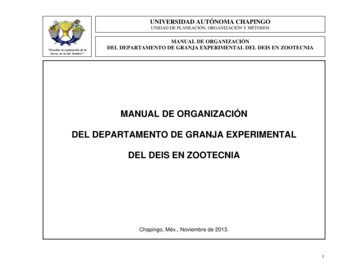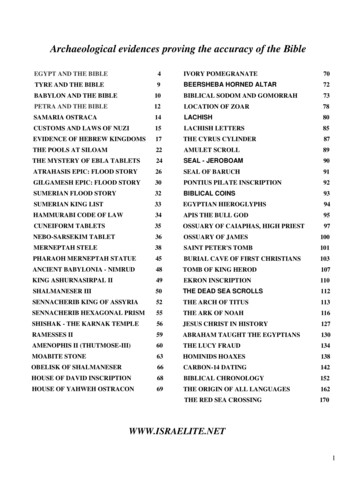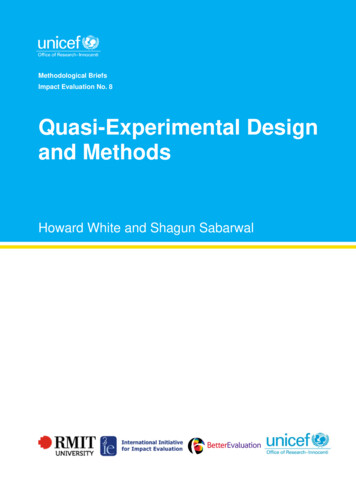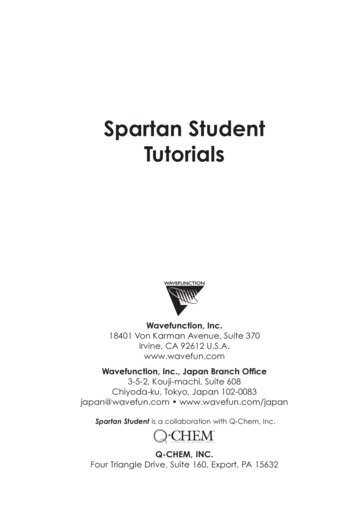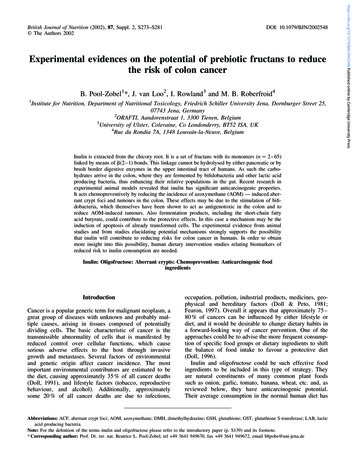
Transcription
DOI: 10.1079/BJN/2002548Experimental evidences on the potential of prebiotic fructans to reducethe risk of colon cancerB. Pool-Zobel1*, J. van Loo2, I. Rowland3 and M. B. Roberfroid41Institute for Nutrition, Department of Nutritional Toxicology, Friedrich Schiller University Jena, Dornburger Street 25,07743 Jena, Germany2ORAFTI, Aandorenstraat 1, 3300 Tienen, Belgium3University of Ulster, Coleraine, Co Londonderry, BT52 ISA, UK4Rue du Rondia 7A, 1348 Louvain-la-Neuve, BelgiumInulin is extracted from the chicory root. It is a set of fructans with its monomers ðn ¼ 2 – 65Þlinked by means of b(2 – 1) bonds. This linkage cannot be hydrolysed by either pancreatic or bybrush border digestive enzymes in the upper intestinal tract of humans. As such the carbohydrates arrive in the colon, where they are fermented by bifidobacteria and other lactic acidproducing bacteria, thus enhancing their relative populations in the gut. Recent research inexperimental animal models revealed that inulin has significant anticarcinogenic properties.It acts chemopreventively by reducing the incidence of azoxymethane (AOM) — induced aberrant crypt foci and tumours in the colon. These effects may be due to the stimulation of bifidobacteria, which themselves have been shown to act as antigenotoxic in the colon and toreduce AOM-induced tumours. Also fermentation products, including the short-chain fattyacid butyrate, could contribute to the protective effects. In this case a mechanism may be theinduction of apoptosis of already transformed cells. The experimental evidence from animalstudies and from studies elucidating potential mechanisms strongly supports the possibilitythat inulin will contribute to reducing risks for colon cancer in humans. In order to obtainmore insight into this possibility, human dietary intervention studies relating biomarkers ofreduced risk to inulin consumption are needed.Inulin: Oligofructose: Aberrant crypts: Chemoprevention: Anticarcinogenic foodingredientsIntroductionCancer is a popular generic term for malignant neoplasm, agreat group of diseases with unknown and probably multiple causes, arising in tissues composed of potentiallydividing cells. The basic characteristic of cancer is thetransmissible abnormality of cells that is manifested byreduced control over cellular functions, which causeserious adverse effects to the host through invasivegrowth and metastases. Several factors of environmentaland genetic origin affect cancer incidence. The mostimportant environmental contributors are estimated to bethe diet, causing approximately 35 % of all cancer deaths(Doll, 1991), and lifestyle factors (tobacco, reproductivebehaviour, and alcohol). Additionally, approximatelysome 20 % of all cancer deaths are due to infections,occupation, pollution, industrial products, medicines, geophysical and hereditary factors (Doll & Peto, 1981;Fearon, 1997). Overall it appears that approximately 75–80 % of cancers can be influenced by either lifestyle ordiet, and it would be desirable to change dietary habits ina forward-looking way of cancer prevention. One of theapproaches could be to advise the more frequent consumption of specific food groups or dietary ingredients to shiftthe balance of food intake to favour a protective diet(Doll, 1996).Inulin and oligofructose could be such effective foodingredients to be included in this type of strategy. Theyare natural constituents of many common plant foodssuch as onion, garlic, tomato, banana, wheat, etc. and, asreviewed below, they have anticarcinogenic potential.Their average consumption in the normal human diet hasAbbreviations: ACF, aberrant crypt foci; AOM, azoxymethane; DMH, dimethylhydrazine; GSH, glutathione; GST, glutathione S-transferase; LAB, lacticacid producing bacteria.Note: For the definition of the terms inulin and oligofructose please refer to the introductory paper (p. S139) and its footnote.* Corresponding author: Prof. Dr. rer. nat. Beatrice L. Pool-Zobel, tel 49 3641 949670, fax 49 3641 949672, email 548 Published online by Cambridge University PressBritish Journal of Nutrition (2002), 87, Suppl. 2, S273–S281q The Authors 2002
B. Pool-Zobel et al.been evaluated to amount to several grams per day (Moshfegh et al. 1999; Van Loo, 1995). Inulin is industriallyobtained from chicory roots by hot water extraction, followed by refining and spray drying. It is thought that chicory inulin and its low and high molecular weight fractionsowe their nutritional properties to the presence of the b(2 –1) bond, which cannot be hydrolysed by the pancreatic norby the brush border hydrolytic enzymes of humans(Schneemann, 1999). As such inulin and oligofructoseescape digestion in the upper intestinal tract and arrivealmost quantitatively (. 90 %) in the colon (Ellgard et al.1997). There these non-digestible oligosaccharides arecompletely fermented. Hereby they selectively promotethe growth of certain groups of bacteria. Amongst theseare the bifidobacteria and the lactobacilli, both of whichproduce lactic acid and are considered to be indicators ofa well-balanced intestinal flora (Gibson & Wang, 1994).This modified intestinal flora and the metabolites, whichit produces, interact with the surface of the intestinaltract in the human body and cause physiological beneficialeffects.Inulin and oligofructose have been subjected to extensive in vitro and in vivo (experimental models) research(Van Loo et al. 1999). At present, the relevance of mostobserved properties has been confirmed in human dietaryintervention studies. The prebiotic effect (Gibson & Roberfroid, 1995; Roberfroid et al. 1998; Kruse et al. 1999), aswell as modulation of lipid metabolism (Williams, 1999),increased calcium absorption (Coudray et al. 1997; Vanden Heufel et al. 1999), modulation of the immunesystem in young children (Saavedra et al. 1999) and modulation of gut function (Den Hond et al. 2000) are importantphysiological properties that may have significant healthpromoting impact in humans.Recently an impressive variety of studies in experimental anticancer models has been performed. This reviewintends to bring together and discuss these data, reflecton state of art, as well as on research necessary to understand putative properties of risk reduction for cancer bythese specific types of prebiotics.Prevention of cancer and related endpoints in animalexperimentsPrevention of chemically induced aberrant crypt foci andcolon cancerSeveral experiments with inulin and oligofructose havebeen performed using one of the most commonly employedanimal models to determine preneoplastic lesions in thecolon of rats (Bird, 1987). The carcinogenic compoundused is azoxymethane (AOM), an alkylating derivative ofdimethylhydrazine (DMH), that specifically targets thecolon of rats, where it induces DNA damage (Pool-Zobelet al. 1996) and tumours. The highest tumour incidenceis in the distal part of the colon. Rats ðn 10Þ are injected(e.g. subcutaneously) with two AOM doses 2 15 mgAOM/kg body weight at an interval of 1 week. Thetumours appear after a period of 45– 52 weeks. Intermediate endpoints induced by AOM can be detected alreadyafter 8 weeks, since it produces large quantities of preneo-plastic lesions in the colon, called aberrant crypt foci(ACF). These abnormalities are due to a thickening ofthe wall in the pericarp of the colon crypts that can bestained and counted. Numerous aberrant crypts occurtogether and are visible as aberrant crypt foci (ACF).Most of these lesions, however, are eliminated by repairmechanisms. Only some of them develop into tumours,of which mainly those with high numbers of aberrantcrypts per foci (multiplicity) are associated with cancerrisk (Magnuson et al. 1993). The application of themodel using AOM as the initiator has been developed tostudy chemoprevention of colon tumours (Wargovichet al. 1992; Pereira et al. 1994). An overview of the variations of this model that has been used to study inulin andoligofructose for preventive properties are presented inTable 1.At least three studies show a reduction of crypt numbersand multiplicity, when adding inulin (10 %) to the diet;Rowland et al. 1998; Coles et al. 2000). In one case(Reddy et al. 1997), it was observed that the effect ofinulin is numerically more important than the effect ofthe oligofructose (Fig. 1). This was attributed to thelower fermentation rate of the inulin, which as a consequence may arrive in more distal parts of the colon,where the injected carcinogen (AOM) exerts its damagingactivity (adapted from Reddy et al. 1997). Other authorscould confirm this in a study where the whole range ofchicory fructans was compared. Verghese et al. (2002a)observed an increasing protection of oligofructose ,inulin , long-chain inulin , a mixture of inulin oligofructose which is a specific mixture of short- and longchain inulin fractions (Verghese et al. 2002a, Van Loo &Jonkers, 2001). However, there is also a report where ina similar experimental approach with oligofructose noreduction of ACF was observed (Gallaher & Khil, 1999).In another experiment (Rowland et al. 1998), it wasobserved that the combination of the prebiotic inulin andthe probiotic B. longum inhibit AOM-induced aberrantcrypt foci in a synergistic manner. Especially the effecton the foci with multiplicity of over four crypts, whichare thought to be the most relevant markers for tumour formation, may be considered of importance in this context(Fig. 2). This was the first demonstration of an effectnow described as ‘synbiotic’, which has been confirmedby another group (Gallaher & Khil, 1999).A more recent study shows that the effect of inulin isdose related. By increasing the concentrations of inulin to2·5, 5 and 10 % in the diet (Verghese et al. 2002a), anincreasingly more visible impact on reduction of ACF incidence is apparent. These authors, moreover, have alsorecently shown that the incidence of colonic tumours isreduced after life-long feeding of 10 % inulin to the rat(Verghese et al. 2002b). Moreover, when offering inulinonly before or only after the carcinogenic AOM injection,or by continuously administering inulin throughout thewhole experiment, the effect of the prebiotic compoundgiven either during the initiation phase (I), or during thepromotion phase (P) or during the whole carcinogenic process ðI þ PÞ was investigated. It was observed that thehighest impact on limiting the numbers of tumours and/or reducing the average size of the tumours was obtainedhttps://doi.org/10.1079/BJN/2002548 Published online by Cambridge University PressS274
S275Table 1. Overview of the different experimental lay-outs using inulin and oligofructose based on the AOM/ACF modelFeedingscheme ()Number ofrats (n )Type of rat(age)AOM(mg/kgBW)Test substanceType of dietOligofructose (10 %)AIN-76Asemi-purifiedI P12male F344(5 w)15ACF/multiplicityReddy et al. 1997CO25 highfat dietP15maleSpragueDawley(3– 4 w)12·5ACF/multiplicityRowland et al. 1998Bolognani et al.2001AIN 93GI P12 (ACF)male F344(5 w)16ACF/multiplicityVerghese et al.2002bI20 (tumors)AIN 93 MPI PI P12AIN 93GI P12Inulin* (10 %)Inulin* (5 %)Inulin* (5 %)þ B. longum (109 )Inulin* (10 %)Inulin*(2·5; 5 and 10 %)Oligofructose (10 %)Inulin (10 %)Inulin* þ oligofructose(10 %)Maltodextrin asplaceboBiomarkerReferenceTumours after45 weeksmale F344(52 w)male F344(5 w)10ACF/multiplicity15ACF/multiplicityVerghese et al. inpress 2002aVerghese (reportprepared forORAFTI)I: initiation phase, rats are fed with the pre/probiotics prior to and during injection with AOM; P: progression phase, rats are fed with the pre/probiotics after injection with AOM; I þ P : initiation and progression phases, rats are fed with the pre/probiotics before and after injection with AOM, throughout life; AOM: azoxymethane; ACF: aberrant crypt foci.* In these studies the inulin used was long-chain inulin idenitified as HP-Inulin.when inulin was applied during the promotion phase,although the dietary supplementation during initiationphase also reduced the number of tumours. In this model,tumours in the small intestine also develop and thesewere also dramatically reduced in the inulin feedinggroups. In this case the effect of supplementation duringthe initiation phase was about as important as duringthe promotion phase (Verghese et al. 2002b).Modulation of sporadic cancers in transgenic APCMINmouse modelInulin may also modulate the occurrence of colon tumours,which are not chemically induced. Studies were performedwith a genetically predetermined model, the APCMINmouse. This transgenic mouse contains a nonsensemutation in the murine APC-gene and it is strongly predisposed to developing intestinal tumours at a relativelyyoung age. It comes close to reflecting the situation ofpatients with familial adenomatous polyposis (FAP), orof individuals carrying the first APC mutation in somaticcells and who are then later predisposed for developingsporadic colon cancer. As is shown in Fig. 3, dietary supplementation with oligofructose (from sucrose) caused areduction in the incidence of colonic tumours but not ofsmall intestinal tumours (Pierre et al. 1997). The authorsmoreover, observed that the oligofructose-fed mice had abetter-developed gut associated lymphoid tissue (GALT).Fig. 1. Life-long feeding of inulin and oligofructose suppresses formation of aberrantcrypt foci in the rat colon. Data from Reddy et al. (1997). B ¼ Control 4, B ¼ 10% oligofructose, B ¼ 10% inulin.https://doi.org/10.1079/BJN/2002548 Published online by Cambridge University PressAnticancer properties of inulin and oligofructose
B. Pool-Zobel et al.Fig. 2. B. longum and inulin (given during the progression phase) synergistically suppress preneoplastic lesions in the colon of rats. Data fromRowland et al. (1998).In a similar model, Mutanen et al. (2000) compared theimpact of a non-specified fraction of chicory inulin withother prebiotic food ingredients, added at higher dosagelevels. Inulin was not effective at these low concentrationssignificantly different from the non-fibre control.Mechanisms-directed experimental approachesBifidobacteria, production and potential role as modifiersof cancer risk factorsBifidobacteria are present in large amounts subsequent toinulin and oligofructose consumption (Gibson et al.1995; Kleessen et al. 1997) and these bacteria are expectedto contribute to the protective effects of the prebiotics(Gibson & Wang, 1994). One important mechanism isprobably the detoxification of genotoxins in the gut. Thishas been shown experimentally in animal models usingthe rat colon carcinogen 1,2-dimethylhydrazine (procarcinogen from which AOM is produced) and determining endpoints ranging from tumorigenesis (Singh et al. 1997)(Fig. 4), to ACF (Reddy, 1998), down to DNA damageinduction (Pool-Zobel et al. 1996) (Fig. 5), all of whichwere markedly reduced. Owing to the complexity ofcancer initiation, of cancer progression and of the exposuresituation in the gut, many types of interactions betweenDMH metabolites and Bifidobacteria may be envisagedto be occurring in the gut. Notably some of our newerstudies have shown that short-lived metabolite mixturesisolated from milk fermented with strains of L. bulgaricusand S. thermophilus are more effective in deactivating etiological risk factors of colon carcinogenesis than cellularcomponents of the micro-organisms (Wollowski et al.1999). Depending on the nature of the exposing riskfactor, different mechanisms including enhanced decomposition or scavenging can be potential biochemical mechanisms involved.Inactivation of carcinogens by modification of toxifyingand detoxifying enzymesLactic acid producing bacteria (LAB), and fermented milkproducts containing LAB, or having bifidogeneticproperties affect gut flora enzyme activities associatedwith colon carcinogenesis (Ling et al. 1994). Theseenzymes, namely azoreductase, nitroreductase, b-glucuronidase, b-glucosidase and 7a-dehydroxylase are expectedto influence the carcinogenic impact of endogenous toxicand genotoxic compounds (Rowland, 1991). ExamplesFig. 3. Oligofructose (from sucrose) reduces the occurrence of colon tumors and develop gut associated lymphoid tissue in APCMIN mice.Data from Pierre et al. (1997). B ¼ CD, O ¼ RS, P ¼ WB, V ¼ FOS.https://doi.org/10.1079/BJN/2002548 Published online by Cambridge University PressS276
S277Fig. 4. Bifidobacteria prevent colon tumorigenesis, pre- and post-initiationapplication. Data from Reddy, (1998). B ¼ Control 3, B ¼ 2% Bifidobacteria.are glucuronide metabolites of the carcinogenic food contaminants, heterocyclic amines. They need to be cleaved byb-glucuronidases before being activated to the ultimatecarcinogens, delivering the electrophilic species (Tureskyet al. 1991). Other examples are azoreductases that activateazo dyes, some of which were formally used as food colouring agents. Nitroaromatics are activated by nitroreductases and are environmental contaminants that may reachthe gut via blood or bile; whereas 7-a-dehydroxylasemay contribute to the genotoxic burden in the gut lumenby activating endogenous hormones to intermediates thatare further converted to yield reactive oxygen species(ROS). Harmful and beneficial bacteria commonly foundin the intestine differ in their enzyme activities (Ballongueet al. 1997). Bifidobacteria and Lactobacilli have loweractivities of these xenobiotic-metabolising enzymes thanBacteroides, Clostridia and Enterobacteriaceae. Forexample, b-glucuronidase is highest in Enterobacteriaand Clostridia (Morra & Boland, 1995). As a consequenceof these enzymes, toxic compounds, already detoxified inthe liver by conjugation, are regenerated by the releaseof toxic aglycones. Furthermore, products formed afterhydrolysis of glucuronides can re-enter enterohepatic circulation and thus delay excretion of compounds. Therefore,although no specific evidence is available, (other than thesegeneral associative suggestions), lower activities of theseenzymes are connected to lower carcinogen exposures. Incontrast, an increase of b-glucosidase could potentiallybe regarded as an advantage for health by releasing glycosides of plant ingredients, some of which have more antimutagenic, antioxidative, anticarcinogenic and immunestimulatory properties than their respective glycosides.Fig. 5. Bifidobacteria prevent N-methyl-N-nitroso-N-nitroguanidine (MNNG)- or 9,2-dimethylhydrazine (DMH) - induced DNA-damage in thecolon of rats in vivo. Abbreviations are: LAB, lactic acid producing bacteria; þ , designates the combinational treatment groups with both carcinogen and LAB; acid, L. acidophilus; htd, heat inactivated; confu, L. confusus; gass, L. gasseri ; long, B. brevi ; therm; S. thermophilus. Datafrom Pool-Zobel et al. (1996) and Wollowski et al. (1999).https://doi.org/10.1079/BJN/2002548 Published online by Cambridge University PressAnticancer properties of inulin and oligofructose
B. Pool-Zobel et al.Fig. 6. Inulin and oligofructose added to the diet increase DMH-induced apoptosis, as detected by the tunnel assay. Data from Hughes & Rowland (2001). a) B ¼ basal, B ¼ FOS, B ¼ Inulin. b) p ¼ proximal, B ¼ distal.The impact of inulin on enzyme activities follows a pattern that could be regarded as potentially beneficial in twostudies whereas in other studies the enzyme levels remainunaltered (Kleessen et al. 1997; Roland et al. 1994). SinceBifidobacteria can have regulatory effects on the growth ofother colonic bacteria, inulin could cause this regulationindirectly by leading to a selective stimulation of Bifidobacteria (Gibson & Wang, 1994).Diet could also be important for enzyme-related detoxifying effects in the colon. Only recently, we haveobtained evidence showing that resistant starch caninduce the chemopreventive enzyme glutathione S-transferase p (GSTp) in the colon of rats with human flora(Treptow-van Lishaut et al. 1999). In contrast, studiesby other groups showed that inulin fed to rats inoculatedwith whole faecal flora enhanced hepatic GST-activity,but did not modulate GST in the colon (Roland et al.1996). This interaction of gut flora with cells of the colonic mucosa or other systemically remote tissues andexpression of GST and other xenobiotic metabolisingenzymes has only been randomly investigated so far. Inthe future related studies on these aspects may revealhow inulin can be protective. Together the findingsimply that there is some potential of pro- and prebioticsto inactivate carcinogenic factors in the colon. However,more conclusive evidence is needed to relate these activities to a lowering of cancer risk either by modulatingluminal or even colon epithelial metabolism.Effects of inulin and gut-products on apoptosisApoptosis, first described by Kerr et al. (1972), is a physiological process of selected cell deletion. As an antagonistof cell proliferation, apoptosis contributes to keeping thecell number in tissues and organs constant, and helps toremove superfluous and damaged cells. If apoptosis is suppressed (e.g. in cells with p53-mutations) this can result inthe development of various tumours (Hollstein et al. 1991).Similarly, for example overexpression of the antiapoptoticgene bcl-2 can lead to lymphoid hyperplasia, lymphomas,and auto-aggression by self-reactive lymphocytes that arenormally deleted by apoptosis. In contrast, the inductionof apoptosis is essential for the therapy of neoplasm andautoimmune diseases (Thompson, 1995; Kroemer et al.1995). During apoptosis the cells undergo various morphological and molecular changes, e.g. the formation of apoptotic blebs of the cell membrane, DNA-fragmentation intypical fragments of 180 base pairs (characteristic DNAladdering), condensation of chromatin, or the externalization of phosphatidylserine (PS) on the extracellular sideof the plasma membrane (Cohen, 1993; Kroemer et al.1995; Hale et al. 1996; Steller, 1995). These changes canbe detected in a great number of apoptosis assays.To study the impact of inulin on apoptosis as a mechanism for anticancer properties of prebiotics, young (3 –4weeks old) male Sprague-Dawley rats ðn ¼ 6Þ were fed adiet containing either inulin (5 %) or oligofructose (5 %)or the basal diet only for a period of 3 weeks. At the endof this period they all were gavaged with a dose of20 mg/kg of 9·12-dimethylhydrazine (DMH) directly inthe stomach. Twenty-four hours later the animals werekilled. The colon was removed and cut mid-way, toobtain a proximal and distal end, and subsequently adequately embedded in paraffin wax. The apoptotic bodiesin twenty good longitudinal sections of crypts werecounted microscopically upon identification by means ofthe Apoptag kit (Appligene-Oncor, France) (Hughes &Rowland, 2001). The results clearly show that there wasan effect on apoptosis. Feeding either inulin or oligofructose to the rats increased their apoptotic index (Fig. 6),which means that the prebiotic fed rats more efficientlyeliminate colonic cells with defective DNA. Here theeffect of inulin was numerically more important than theeffect of oligofructose. It is remarkable that this isthe case both in the proximal and in the distal colon(Hughes & Rowland, 2001).Short-chain fatty acids, products of gut fermentationOne of the bacterial metabolites of fructan fermentation isbutyrate, a short-chain fatty acid, which is one of the mostphysiologically relevant products of gut flora fermentation(Cummings et al. 1987). It is found in millimolar concentrations in the lumen as a consequence of microbialhttps://doi.org/10.1079/BJN/2002548 Published online by Cambridge University PressS278
carbohydrate degradation and serves as a principle energysource for colon epithelial cells (Roediger, 1989). Ahypothesis is that butyrate protects against colon cancerby inhibiting colon cell proliferation and inducing differentiation (Rehman et al. 1998; Sesink et al. 2000). Moreover,it may additionally confer protection by promoting apoptosis in colon tumour cell lines (Hague et al. 1995; Hague &Paraskeva, 1995). It is further implicated that dietary fibremay protect against colon cancer through the production ofbutyrate by the colonic microflora (Van Munster et al.1994; McIntyre et al. 1993; Perrin et al. 2001). Thereforesome of the properties inulin has shown in rats in vivo,including the first described mechanisms of apoptosis,could be due to butyrate.In contrast, in vitro data with human biopsy specimensand other in vivo data in animals, show that butyrateseems to have opposite effects in non-transformedcolon cells where it acts proliferate instead of antiproliferative (Lupton, 1995). For diet and cancer preventiontherefore, some additional mechanisms could be causedby butyrate in non-transformed colon cells. In fact, theblocking agent activities involved in primary cancer prevention are expected to be of equal importance for overall risk reduction (Wattenberg, 1992). These activitieslead to reduced exposure to genotoxic risk factorseither by inhibiting their formation, by scavenging reactive intermediates or by modulating the balance ofmetabolizing systems in cells to favour deactivation ofcarcinogens (Johnson et al. 1994). In this context wehave recently been able to show that pre-incubation ofhuman and rat primary colon cells with Na-butyrate protects them from genotoxic effects induced by hydrogenperoxide (Abrahamse et al. 1999; Pool-Zobel et al.1995). Butyrate may also alter the metabolic balance inhuman colon tumour cell lines by inducing glutathioneS-transferase (GST) (Stein et al. 1996; Kirlin et al.1999). GST are a family of enzymes that catalyze theconjugation of reactive chemicals with glutathione(GSH) and play a major role in protecting cells fromthese chemicals (Awasthi et al. 1994). GSH-conjugatesare subsequently eliminated via active transport systems(Ishikawa, 1992). In human and rat colon tissue,GSTP1 is the major form of this enzyme and it is inducible by dietary factors (Peters et al. 1989; Acheson et al.1967; van Lieshout et al. 1996; Nijhoff et al. 1995).Butyrate may also increase secretion of mucin, a barrierwhich can deactivate carcinogens thus protecting the epithelial cells (Kassie et al. 1999). Together the findingsare subsequently the possible extensions in the line ofevidence that fibre may be protective on account of butyrate production by the gut flora. In this context, an interesting recent study has shown that only fibres promotinga stable butyrate colonic ecosystem decrease the rate ofaberrant crypt foci in rats (Perrin et al. 2001).ConclusionFrom the present set of results, it can be stated that there isconsistent data available suggesting that the prebiotic chicory inulin and its fractions have anticarcinogenic activities,S279most probably through particular modification and maintenance of metabolic activity of the intestinal flora.In rats a prebiotic effect, resulting in the proliferation ofbifidobacteria (with the major metabolites lactate or acetate), as well as of other bacteria (with the metabolites butyrate or propionate and acetate), could be responsible for theobserved anticancer effects in the colon of animals. Themetabolites will reduce the pH of the colon lumen anddirect interactions with cells of the colon epithelium maycause enhanced expression of phase II (deactivatingenzymes), such as GST, or induce apoptosis to removetransformed cells, or increase mucin, a barrier which protects from attack by reactive compounds.Since there is established evidence of a prebiotic effectin humans, these data justify further research with humanvolunteers using biomarkers to reveal a potential riskreduction in the gut lumen. Appropriate methods to determine the genotoxic burden in the gut lumen, or to analyseDNA damage and other parameters in cells isolated fromcolon biopsy specimens, are available. On the basis of sofar obtained preliminary results they are probably sufficiently sensitive to reveal a significant effect of inulin oroligofructose intervention, if present (Osswald et al.2000; Pool-Zobel & Leucht, 1997; Pool-Zobel et al.1999). Such studies would allow evaluating the possiblerole of these food ingredients to reduce carcinogenic/genotoxic risk factors in the colon.At present a human intervention study is being planned,and its outcome promises to yield more information in thepotentially advantageous properties of inulin and relatedprebiotics in the human colon.AcknowledgementsThe results described in this paper are part of the basis of ahuman dietary intervention study (SYNCAN,QLK1-1999346) sponsored by the EU.ReferencesAbrahamse SL, Pool-Zobel BL & Rechkemmer G (1999) Potential of short chain fatty acids to modulate the induction of DNAdamage and changes in the intracellular calcium concentrationin isolated rat colon cells. Carcinogenesis 20, 629– 634.Acheson ED, Hadfield EH & Macbeth RG (1967) Carcinoma ofthe nasal cavity and accessory sinuses in woodworkers. TheLancet 2/11, 311– 312.Awasthi YC, Sharma R & Singhal SS (1994) Human glutathioneS-transferases. International Journal of Biochemistry 26,295– 308.Ballongue J, Schumann C & Quignon P (1997) Effects of lactulose and lactitol on colonic microflora and enzymatic activity.Scandinavian Journal of Gastroenterology 32, Suppl. 222,41 – 44.Bird RP (1987) Observation and quantification of aberrant cryptsin the murine colon treated with a colon carcinogen: preliminary findings. Cancer Letters 37, 147– 151.Bolognani F, Rumney CJ, Coutts JT, Pool-Zobel BL & RowlandIR (2001) Effect of lactobacilli, bifidobacteria and inulin on theformation of aberrant crypt foci in rats. European Journal ofNutrition 40, 293–300.Cohen JJ (1993) Apoptosis. Immunology Today 14, 126– 130.Coles B, Yang M, Lang NP & Kadlubar FF (2000) Expression ofhttps://doi.org/10.1079/BJN/2002548 Published online by Cambridge University PressAnticancer properties of inulin and oligofructose
B. Pool-Zobel et al.hGSTP1 alleles in human lung and catalytic activity of thenative protein variants
colon of rats, where it induces DNA damage (Pool-Zobel et al. 1996) and tumours. The highest tumour incidence is in the distal part of the colon. Rats -n 10ƒare injected (e.g. subcutaneously) with two AOM doses 2 15mg AOM/kg body weight at an interval of 1 week. The tumours appear after a period of 45-52 weeks. Intermedi-





